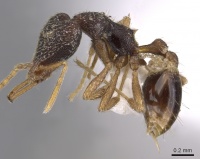Strumigenys deuteras
| Strumigenys deuteras | |
|---|---|

| |
| Scientific classification | |
| Kingdom: | Animalia |
| Phylum: | Arthropoda |
| Class: | Insecta |
| Order: | Hymenoptera |
| Family: | Formicidae |
| Subfamily: | Myrmicinae |
| Tribe: | Attini |
| Genus: | Strumigenys |
| Species: | S. deuteras |
| Binomial name | |
| Strumigenys deuteras Bolton, 2000 | |
Noted as being found in rainforest and open forest, all of the few collections of this species were collected in litter samples.
Identification
Bolton (2000) - A member of the signeae complex in the Strumigenys godeffroyi-group. Closest related to Strumigenys cingatrix but that species has the katepisternum entirely reticulate-punctate; see notes under Strumigenys perplexa and Strumigenys cingatrix. Many samples of deuteras (including the type-series) are darkly coloured and may be almost black. However, some series are much lighter, brownish yellow to yellow; some intermediates between these and the darker forms are known. Such colour variation is not uncommon in the strumigenyiform dacetines and is often a function of altitude; it is not accorded any particular taxonomic status here.
Keys including this Species
Distribution
Latitudinal Distribution Pattern
Latitudinal Range: -18.99° to -24.36666667°.
| North Temperate |
North Subtropical |
Tropical | South Subtropical |
South Temperate |
- Source: AntMaps
Distribution based on Regional Taxon Lists
Australasian Region: Australia (type locality).
Distribution based on AntMaps
Distribution based on AntWeb specimens
Check data from AntWeb
Countries Occupied
| Number of countries occupied by this species based on AntWiki Regional Taxon Lists. In general, fewer countries occupied indicates a narrower range, while more countries indicates a more widespread species. |

|
Estimated Abundance
| Relative abundance based on number of AntMaps records per species (this species within the purple bar). Fewer records (to the left) indicates a less abundant/encountered species while more records (to the right) indicates more abundant/encountered species. |

|
Elevation Range
| Species | Elevation (m asl) | |||||
|---|---|---|---|---|---|---|
| 200 | 400 | 600 | 800 | 1000 | 1200 | |
| Strumigenys deuteras | 10-20 | 20-30 | 20-30 | 60-70 | 30-40 | 70-80 |
| Shading indicates the bands of elevation where species was recorded. Numbers are the percentage of total samples containing this species. | ||||||
Biology
|
Castes
Nomenclature
The following information is derived from Barry Bolton's Online Catalogue of the Ants of the World.
- deuteras. Strumigenys deuteras Bolton, 2000: 959, fig. 523 (w.) AUSTRALIA.
Unless otherwise noted the text for the remainder of this section is reported from the publication that includes the original description.
Description
Worker
Holotype. TL 2.5, HL 0.64, HW 0.50, CI 78, ML 0.28, MI 44, SL 0.35, SI 70, PW 0.28, AL 0.66. With characters of signeae-complex. Apical fork of right mandible with a small intercalary tooth that is flanked above and below by a minute denticle. Apicoscrobal hair short, stiff and simple, shallowly curved. Reticulate-punctate sculpture of cephalic dorsum very closely packed and with a granulate appearence. Occipital margin with 4-6 short erect hairs present. Main row of curved projecting hairs on leading edge of scape simple to extremely narrowly spatulate; secondary hairs on leading edge only fractionally more slender and fractionally shorter, not easily distinguished from components of main row. Pronotal humeral hair stiff and simple, straight to shallowly curved; pronotal dorsum with 1-2 pairs of stiffly erect simple hairs and mesonotum with 3 pairs of similar hairs. Entire dorsal alitrunk finely and densely reticulate-punctate. Katepisternum mostly to entirely smooth but metapleuron and side of propodeum entirely evenly reticulate-punctate, without un sculptured patches. Postpetiole disc finely superficially sculptured, sculpture faint and almost effaced in places. Hairs on first gastral tergite short and straight, simple and stiffly erect, apically blunt. Basigastral costulae at least as long as disc of postpetiole.
Paratypes. TL 2.4-2.5, HL 0.62-0.68, HW 0.48-0.51, CI 76-80, ML 0.25-0.28, MI 40-44, SL 0.32-0.36, SI 67-71, PW 0.26-0.30, AL 0.62-0.70 (7 measured).
Dimensions of non-paratypic workers. TL 2.3-2.5, HL 0.57-0.65, HW 0.42-0.50, CI 74-79, ML 0.24-0.28, MI 40-44, SL 0.29-0.36, SI 66-74, PW 0.25-0.28, AL 0.56-0.66 (8 measured).
Type Material
Holotype worker, Australia: Queensland, Kroombit Tops, 65 km. SW Gladstone, 22-26.ii.1982, Q. M. Berlesate No. 383, 1100 m., rainforest, sieved litter (G. Mollteirh & G. Thompson) (Australian National Insect Collection). Paratypes. 4 workers with same data as holtype; 2 workers with same data but Berlesate No. 384, stickbrushing; 3 workers with same data but Berlesate No. 386, 1050 m., open forest (R. Raven) (ANIC, The Natural History Museum).
- Holotype, worker, Kroombit Tops, 65km SW Gladstone, Queensland, Australia, Monteith,G.B. & Thompson,G., ANIC32-017717, Australian National Insect Collection.
- Paratype, 3 workers, Kroombit Tops, 65km SW Gladstone, Queensland, Australia, Monteith,G.B. & Thompson,G., ANIC32-017718, Australian National Insect Collection.
- Paratype, 2 workers, Kroombit Tops, 65km SW Gladstone, Queensland, Australia, Monteith,G.B. & Thompson,G., ANIC32-017719, Australian National Insect Collection.
- Paratype, 3 workers, Kroombit Tops, 65km SW Gladstone, Queensland, Australia, Monteith,G.B. & Thompson,G., ANIC32-017720, Australian National Insect Collection.
- Paratype, 1 worker, Kroombit Tops, 65km SW Gladstone, Queensland, Australia, The Natural History Museum.
References
- Bolton, B. 2000. The ant tribe Dacetini. Memoirs of the American Entomological Institute. 65:1-1028. (page 959, fig. 523 worker described)
- Burwell, C.J., Nakamura, A. 2020. Rainforest ants (Hymenoptera: Formicidae) along an elevational gradient at Eungella in the Clarke Range, Central Queensland coast, Australia. Proceedings of the Royal Society of Queensland 125: 43-63.
References based on Global Ant Biodiversity Informatics
- Bolton, B. 2000. The Ant Tribe Dacetini. Memoirs of the American Entomological Institute 65
- Burwell C.J., and A. Nakamura. 2011. Distribution of ant speces along an altitudinal transect in continuous rainforest in subtropical Queensland, Australia. Memoirs of the Queensland Museum -Nature 55(2): 391-411.

